Friedrich Luft of the Max Delbrück Center for Molecular Medicine in Berlin is seventy-three years old. He has a lifetime of research behind him and more than enough prizes and honors. Luft could easily sit back and enjoy retired life—he could, that is, if it weren’t for a Turkish family from a small village close to the Black Sea. Hidden in this family’s genes is the key to understanding hypertension, a disease so widespread that that one out of every two Europeans will suffer from it over the course of their lives. Luft and his team have found this key. Now it’s time for the world to hear about it.
The medical mystery begins in 1960 with that same Turkish family: Kemal (name changed) was standing over his uncle’s grave muttering to himself. The uncle wasn’t even fifty—too young to die. Death didn’t send a sign or a messenger, only a slight headache and little dizziness. Kemal suffered from the same symptoms. Many people in his family died young. Then he suddenly realized. His fingers. Just like his uncle, he too had extremely short fingers. Did the fingers have something to do with his uncle’s premature death?
Kemal traveled to see a doctor in a faraway city. The doctor was curious about Kemal’s hands and asked if everyone in his family had such short fingers. “Not everyone, but many,” Kemal replied. The doctor took Kemal’s blood pressure. The values were astronomically high, he had never seen such a measurement before. Because of Kemals family history, he suspected a hereditary disease and recommended the young man to seek further advice at the Ankara University Hospital. “You may find a specialist there who can tell you more.”
Kemal returned from his first journey to Ankara disappointed. There was no specialist for his problem, only a pediatrician who worked on hereditary diseases. But this doctor had never seen a case like his, and he told Kemal bluntly that he couldn’t help him. All he did was leaving a short note in a scientific journal about the case. Kemal didn’t let things rest. Ten years later he went back to Ankara, accompanied by his cousin and her one-year-old child. They found another doctor. This one listened carefully, asked a number of questions and finally made Kemal this promise: “I’ll come visit you, and I’ll examine every member of your family.”
The doctor’s name was Nihat Bilginturan and he had previously held a research position as at Harvard University. He was driven by curiosity: Was this an entirely new hereditary disease?
He needed to find out. In spring of 1970 he traveled with a photographer to Kemal’s village but nearly didn’t make it. It was raining so heavily when he arrived that the dirt path had turned into mud and slime and their off-road vehicle got stuck. A donkey driver who happened to be passing their way saved them.
Fourty relatives packed into Kemal’s house in order to have the doctor examine them. Bilginturan asked each one about parents, grandparents, uncles, aunts, and distant cousins. Based on their responses he began to put together a family tree. During the physical examinations his suspicion was confirmed: the family members with short fingers suffered from astronomically high blood pressure. And it was beginning to look like they passed their disease on to every second child, regardless of whether it was a boy or a girl.
The doctor stayed for a week. The people hoped that Bilginturan would be able to help them. On the eve of his departure they all gathered to hear his recommendation: “There’s only one way to stop this disease,” he said honestly, “no more children.” The family members were upset. “Of course we’re going to have children! We’ll just have to accept that some of us will die young,” they replied. Bilingturan couldn’t do anything else for them and he left. Later, in 1973, he wrote an academic paper in the Journal of Medical Genetics about what he had seen. Hardly anyone paid attention.
Germany, 1993, twenty years later. The geneticist Thomas Wienker is looking for a new job. A spot opens up at the Max-Delbrück Center for Molecular Medicine in Berlin. The nephrologist Friedrich Luft is a researcher there. Wienker is supposed to give a lecture on special types of hypertension that are passed on by a single gene. The problem is that no one knows if families like the ones these cases describe actually exist. Hypertension is multifactorial—many genes, in addition to nutrition and environment, play a role in its development.
Wienker was faced with a difficult task. At the time, you couldn’t just search the Internet for an answer—and he spent many nights digging through medical journals and compendia of key words and diseases at the Freiburg University library looking for an answer. If he could find a family in which a single gene caused acute hypertension, future research might be able to explain how the body regulates blood pressure. Finally Wienker found something that he would later call a genetic “goldmine”: Bilginturan’s article on the Turkish family.
Friedrich Luft was beside himself with excitement. Six months later Wienker was working in Berlin.
Tegel Airport, Berlin, 1994. Kemal would have been happy had he lived to see this day, but he died three years earlier. The bravest members of his family had dared to venture to the big city of Berlin, with its deafening noise, its constant turmoil, its foreign languages, all of which were new to them. It was the adventure of their lives. Cafer*, Kemal’s son, had brought them over. He was bigger than the rest and the only one who didn’t suffer from the hereditary disease. He wanted to finish what his father had started.
They came to lend their bodies to research. They knew their cells might carry the hidden key to understanding that most mysterious and wide-spread disease: acute hypertension. They also knew that they would not reap the benefits of the research, but perhaps their children would. It was Friedrich Luft who explained this all to them, or rather had it explained it to them. Six months earlier he had visited them, accompanied by two Turkish brothers, Okan and Hakan, who were now at the airport to greet the family members. Okan studied medicine and Hakan was a young doctor. Both now belonged to Luft’s team.
All of the researchers could sense that their life’s work was about to begin.
A marathon week of tests and examinations began. It was a strange experience for people who had never been to see a doctor before. The researchers measured their hearts, which should have been significantly bigger because of the high blood pressure, but their hearts were normal. They looked for kidney damage, another common side effect of high blood pressure, but their kidneys were functioning normally. The Turkish patients seemed surprisingly healthy. Their bodies had developed mysterious defense mechanisms. “If we knew what was protecting their bodies,” Friedrich Luft mused, “it might well lead to future treatments for hypertension.” Yet they were still dying young, mostly of strokes. The arteries in their brains had clearly not developed defense mechanisms.
All of the researchers could sense that their life’s work was about to begin.
Friedrich Luft waited anxiously for the results of his search for possible causes of the high blood pressure. He hoped they wouldn’t find any. Here’s why: there are two kinds of hypertension. In the most common form—primary hypertension—there is no root cause, or rather the cause is unknown. In the less common form—secondary hypertension—the arteries of the kidney may be partially occluded, or there may be a disruption in hormone release or function, giving rise to the hypertension. Luft hoped that the family’s high blood pressure would lead to new discoveries about primary hypertension, and he was very relieved when his team didn’t find any obvious causes.
Hard at work in the laboratory, Sylvia Bähring and Atakan Ayidin looked for the unknown gene. They had taken the blood from which they were now trying to extract the genetic information behind the disease. This wasn’t easy in 1995 because most of the human genome hadn’t yet been decoded. But after a year, they found a possible gene. It helped determine bone growth and could explain the shorter fingers. They thought they had reached their goal.
Soon the family tree was also complete. One hundred and fifty years ago a village farmer married a woman who came from far away in eastern Anatolia. She was small and had conspicuously short fingers. No one knows exactly how many children this ancestor bore, but she passed on her genetic material at least once. Today there are roughly thirty relatives in the area who have inherited the short fingers and high blood pressure. Would the gene that the researchers had targeted explain both?
They celebrated too soon. The gene they had found was not mutated, as they had suspected. Instead the problem had to do with a common portion of the human genome, on which we now know there are seventy-eight genes. At the time, these genes were not known to the scientific world, and the team still had twenty years of hard work ahead of them before these discoveries came out. They would often doubt themselves, they would often want to give up. Again and again and it would be Friedrich Luft who pushed them toward their shared goal.
Hard work: the laborious deciphering of blood pressure codes
Friedrich Luft also had to motivate the Turkish patients. What would they gain from making their bodies and genes available to researchers? This question had been bothering Friedrich Luft since the beginning. It was clear that he had to give them something. He needed them as long-term partners in his project, and they desperately needed medication for their acute hypertension. Like everyone else, they were supposed live long enough to see their grand children grow up.
For this new task, Luft approached the youngest member of his team, Okan Toka. The son of a first generation Turkish migrant worker, Okan had only ever visited home during summer vacations, but in 1996, he was going to get to know Turkey more intimately.
In middle of a freezing winter, Okan rented a small, stove-heated apartment on the coast of the Black Sea. The lab in Berlin bought him a car which he used to visit patients in the mountains. Soon he would be bringing them blood pressure medication, taking blood pressure measurements from the past twenty-four hours and collecting blood and urine samples.
The medicine Okan was giving out then is the same one doctors still use today, more than twenty years later. One of the great problems in treatments for hypertension is the lack of innovation. The research is still stuck where it was in the nineties, facing largely the same problems.
One of the great problems in treatments for hypertension is the lack of innovation.
Doctors frequently use up to three different medications in order to keep levels under control, and every fifth patient is drug resistant. The drugs in use have side effects like fatigue and impotence, and in a strange twist, people who suffer from hypertension usually feel much better before beginning treatment than they do once they start a drug regimen. As a result, nearly half of all patients given drugs for hypertension stop taking them as prescribed after only a year.
All of these drugs lower vascular resistance, allowing blood to flow more easily through arteries. They work by targeting various switches in the body that help regulate blood flow. Some relieve pressure on the heart, others drain tissue, widen blood vessels, calm the nervous system, or regulate hormones in the kidney. But none of these medications attacks the problem at its root, and the deepest causes of primary hypertension, which nearly ninety percent of all patients with high blood pressure suffer from, remain unknown.
Okan soon became the contact person for all emergencies. After spending many hours going back and forth with a local judge, he got one of his patients released from jail. Another patient was supposed to be drafted but Okan requested a postponement from the local governmental offices. He listened, he took care of problems, he helped. Slowly, he gained respect among the family members, and finally he also made a breakthrough in his research. The drugs he was prescribing were causing blood pressure in his patients to drop to tolerable levels. These results were proof that Okan had earned his M.D., and they once again confirmed that the hereditary disease resembled primary hypertension.
Since then, Okan has been traveling to Turkey every two years to deliver large supplies of these drugs. All members of the family receive them for free, and since Okan’s arrival, only one member of the family has died young of complications resulting from hypertension. Finally, after more than one hundred and thirty years, it seemed like the curse had been lifted—the members of the short-fingered family would live to see their grand children grow up.
But the puzzle was far from being solved. Where in the body lay the “switch” that elevated blood pressure to such astronomical heights?
The researchers groped blindly for answers. Years after they had discovered the peculiar region in the genome they still didn’t know how many genes lay hidden in it. They were faced with a slew of genetic code that they couldn’t read because at the time very few genes were known; it was a knot they couldn’t easily untangle. Piece by piece, Friedrich Luft had his team decode the suspicious string of chromosomes. It was grueling work that would take many years to complete.
A number of coincidences and a major discovery spurred these gene detectives forward.
But all of a sudden a number of coincidences and a major discovery spurred these gene detectives forward. At conferences, they were often approached by doctors who said the same thing: “I’ve got patients that match your description.” And soon the team of scientists had found five additional families in which short fingers and high blood pressure were mysteriously paired. They lived in Canada, the United States, France and South Africa—and they were not related. The same general portion of the genome stood out in all of them, but the size and position of the piece in question varied slightly from family to family. This helped researchers narrow down the guilty gene further and further.Then, in 2001, the world was rocked by a discovery: the entire human genome had been decoded. Suddenly, Luft’s team had access to a catalogue of all the newly discovered genes. This catalogue led them directly to a new prime suspect. The gene in question contained the blueprint for a protein that the pharmaceutical industry had thought was responsible for hypertension and coronary heart disease in the 1980s. It’s called Phosphodiesterase. Today we know that there are eleven subtypes of the protein; back then this wasn’t known. In the eighties, Pfizer had been experimenting with a drug that would block Phosphodiesterase. The result was one of greatest coups in the history of medicine because of the unexpected side effects—longer-lasting erections. It was the birth of Viagra, a multi-billion-dollar business for Pfizer. Viagra doesn’t lower high blood pressure, so while Luft’s team continued to focus on Phosphodiesterase, they directed their attention to another subtype, 3a, which is especially common in human arteries.
Luft had to listen to people tell him that he and his team couldn’t do it.
The culprit was now in their sights but the team couldn’t seem to pin it down. They were looking for a mutation in the protein-producing gene but just couldn’t find one. Years of stagnation followed. Again and again, Luft had to listen to people tell him that he and his team couldn’t do it, couldn’t produce any useful results.
He flew the Turkish patients to Berlin three more times to conduct further experiments. It cost an enormous amount of money and energy, and Luft couldn’t even guarantee that they would find answers. Still, the core members of his team stuck with him.
At the finish line: Culprit caught, new medications are within sight
In the end, a sixteen-year-old boy saved them. His genes were mutated slightly differently from those of his parents, and his fingers appeared almost normal in length despite his high blood pressure. With the help of this boy, Luft’s team traced its way back through many detours to the original suspect—the PDE3A gene. To their dismay they found there had indeed been a mutation back when they first suspected the gene was responsible. They had simply missed it.
Twenty years after the start of their adventure Luft’s team had found proof: the malefactor that plagued this Turkish family was a mutated version of the PDE3A protein. The protein plays an essential role in blood pressure regulation in humans and it also indirectly regulates bone growth. When it’s overactive—as in the case of the short-fingered family—bones become too short, and the walls of arteries too stiff. As a result, blood pressure skyrockets.
Any drug that blocks this protein would most likely lower blood pressure. But if that were all they had found, Luft’s team would have only produced one of many basic pieces of research that the pharmaceutical industry routinely ignores. But there’s a crucial difference in this case: the drug that helps lower high blood pressure already exists. It wasn’t Luft’s team that developed it, but the pharmaceutical giant, Bayer. It’s called Riociguat and it blocks PDE3A indirectly. Up until now it was used to counter a different illness: pulmonary hypertension. Clinical trials for patients with primary hypertension, which is resistant to most treatments, could theoretically begin at any point. The drug could be the basis for a new generation of blood pressure medications. It was an incredible leap forward after two decades of stagnation.
On an overcast day in March 2015, Friedrich Luft is sitting at his desk and staring at a screen. He looks sad, not like the heroic researcher he so obviously is. He still hasn’t heard back from the editor of Nature Genetics, Mount Olympus of genetic research. What they’re going to publish will send waves through the medical world. The study has long been accepted, but Luft is still afraid that he and his team’s joint life work will be sidelined at the last moment.For a year and a half the paper has gone back and forth, the peer reviewers always coming up with new requests and changes. Standard academic caviling.
Luft still has many questions. How will all of this unfold? What will the pharmaceutical industry do with the information?
A month later, the email finally arrives! The world will soon hear of his team’s breakthrough – in Nature Genetics on May 11th, 2015. “We solved the scientific problem,” says Luft. “The rest is up to the world.”

























